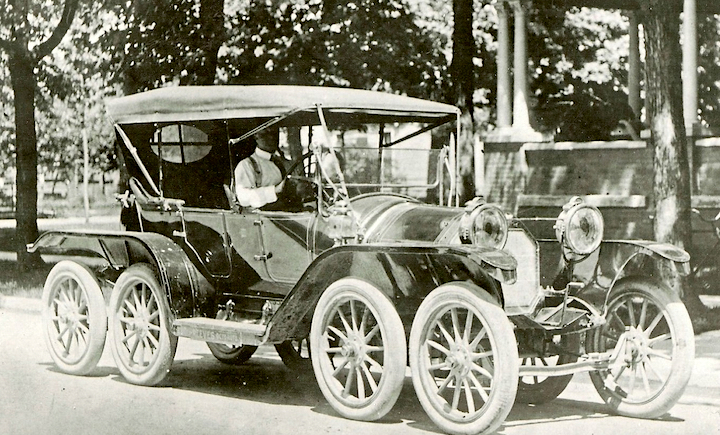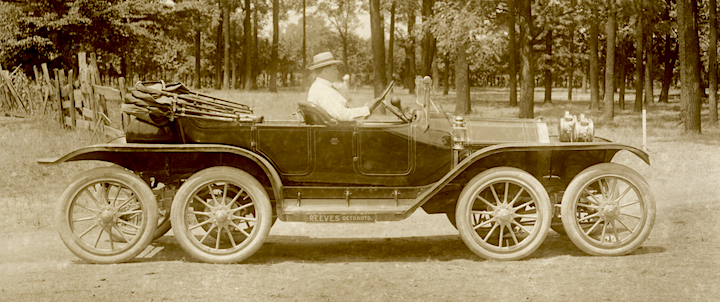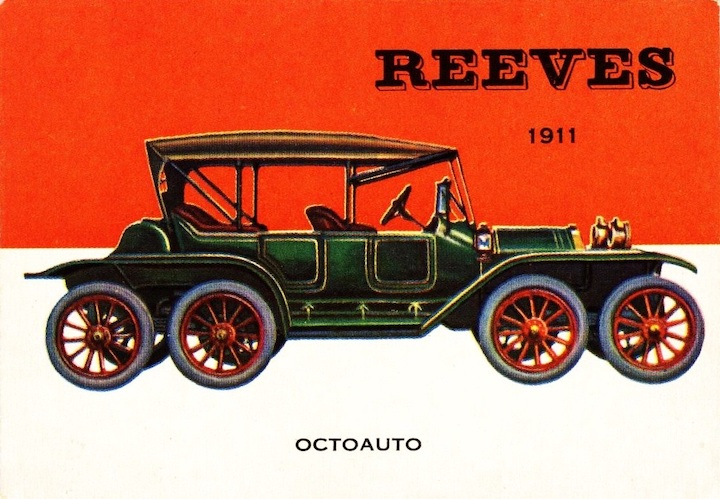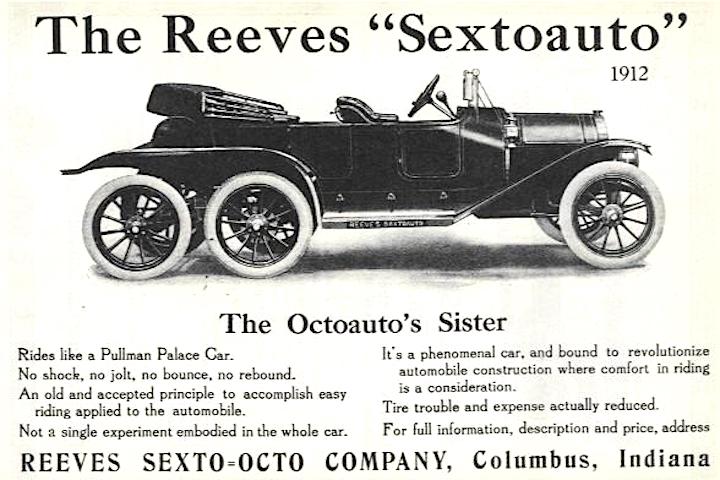1911 Reeves Octoauto was an 8-wheel technological marvel

By Jeff Peek
Hagerty
(February 21, 2021) Eight is enough — exactly the right amount, as it turns out, when it comes to the number of wheels on a car. In 1911, Milton Reeves tested that theory with an eight-wheel vehicle he called the Octoauto. The odd-looking automobile wasn’t his first creation or his last, but it was definitely Reeves’ most significant, even though it wasn’t a financial success. Reeves, a native of Indiana who was born during the Civil War, was among the early architects of the horseless carriage in the late 1880s. In fact, his initial iteration is widely considered the fourth or the fifth American automobile ever created.
Reeves’ historic roots as an inventor officially began at age 15 when, while working in a sawmill, the teenager noticed that his coworkers could not control the speed of the pulleys used to power the saws, a problem that often caused the wood to split. Reeves provided the solution by designing a variable-speed transmission that allowed the saw blades to turn slower or faster as needed. He would go on to patent 100 inventions in his 60 years.
Reeves was in his early 20s when he was sold on the idea of motorized transportation and began to build his first automobile — a four-wheeler then referred to as a motocycle — with the financial backing of his brothers. According to silodrome.com, his variable-speed transmission was ideally suited to work in tandem with a twin-cylinder, two-stroke, 6-horsepower Sintz marine engine. Reeves’ three-seat motocycle was steered by a tiller operated from the back seat; the body was built by the Fehring Carriage Company.

Reeves also created a seven-seat “Big Seven” model, and in 1898 built the “Big Motocycle,” a 20-seat bus with huge wheels that were nearly six feet in diameter. To reduce noise from the two-stroke engine, Reeves invented a double-muffler exhaust system (an industry first), but he grew tired of the heavy fumes and decided to build a more efficient engine instead. By 1898, he had created two — a 6-horsepower version and a 12-horsepower variety.
Instead of continuing to create and develop his automobiles, Reeves closed shop in 1899 when his family decided to concentrate on agricultural and industrial products. It would be five years before Reeves picked up where he’d left off, and he quickly made up for lost time by unveiling two new models in 1904: the Model D, with a 12-hp engine, and the Model E, boasting a 18–20-hp mill.
A year later, Reeves unveiled his new valve-in-head, air-cooled engine, which featured individually cast cylinders to help with air cooling, splash lubrication, and inlet and exhaust on opposite sides of the engine to create a “cross flow” effect. The engines were so successful that they were used in vehicles built by Auburn, Moon, Chatham, Autobug, and Mapleby.

1953-54 Topps World on Wheels trading card
In spite of his success as an engine builder, Reeves is best known for his eight-wheel, 20-foot long Octoauto, which may seem unconventional today but made perfect sense for the time. In 1911, Reeves modified a 1910 Overland by adding four wheels and creating two sets of four in front and back. Roads in his time were generally horrendous (particularly in rural areas), and since suspension consisted of leaf springs and tire design wasn’t what it is today, passengers felt every bump and pothole.
Reeves simply borrowed a design employed on railroad cars, which used quad-wheel “bogies” to distribute the weight and smooth out the ride. According to silodrome.com: “The design incorporated front twin steering coupled with steering by the wheels on the rearmost axle. The forward rear axle had no steering and was the only one that was driven, making this an 8×2. The driven axle was the only one that had drum brakes on each wheel.”

The idea worked brilliantly. So much so that few argued when Reeves began calling the odd-looking automobile “the only easy riding car in the world.” The problem was that it cost too much to build. The four-passenger Octoauto—powered by a 40-horse engine—retailed for $3,200, which is nearly $100,000 today.
No amount of praise or attention could save Reeves’ Octoauto, so he remodeled it — most notably removing two wheels from up front — and in 1912 rebranded it as the Sextoauto. Reeves later took a gamble by building the six-wheeler on a new Stutz chassis, but that only increased the price. Sales were few.
Reeves never built another car, and he died in 1925, two months before his 61st birthday.
Although the Octoauto and Sextoauto were financial failures, and none are known to exist today, there’s no disputing that they were technological marvels, regardless of how many wheels they had.
